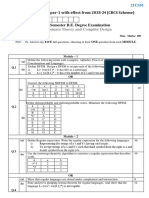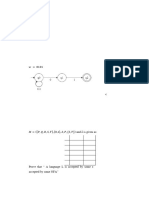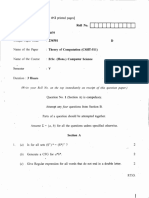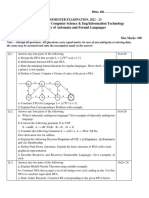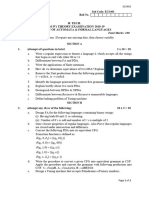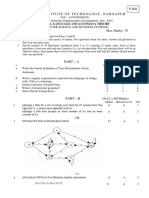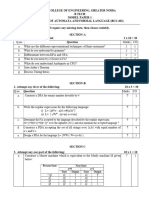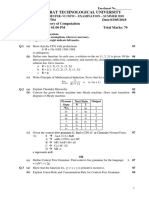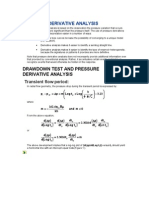Model Question Paper-1 With Effect From 2019-20 (CBCS Scheme)
Model Question Paper-1 With Effect From 2019-20 (CBCS Scheme)
Uploaded by
study materialCopyright:
Available Formats
Model Question Paper-1 With Effect From 2019-20 (CBCS Scheme)
Model Question Paper-1 With Effect From 2019-20 (CBCS Scheme)
Uploaded by
study materialOriginal Title
Copyright
Available Formats
Share this document
Did you find this document useful?
Is this content inappropriate?
Copyright:
Available Formats
Model Question Paper-1 With Effect From 2019-20 (CBCS Scheme)
Model Question Paper-1 With Effect From 2019-20 (CBCS Scheme)
Uploaded by
study materialCopyright:
Available Formats
18CS54
Model Question Paper-1 with effect from 2019-20 (CBCS Scheme)
USN
Fifth Semester B.E. Degree Examination
AUTOMATA THEORY AND COMPUTABILITY
TIME: 03 Hours Max. Marks: 100
Note: Answer any FIVE full questions, choosing at least ONE question from each MODULE.
Module – 1
Define the following with example. i). Alphabet ii). Power of an alphabet.
(a) 5
iii). Concatenation iv). Language
Define DFSM. Draw a DFSM to accepts
i) decimal strings which are divisible by three.
(b) 10
Q.1 ii) L = {w / w ∈ {a,b}* is the string with even no. of a’s and odd no. of b’s}
iii) L ={w/ w ∈ {a,b}* is the string of a’s and b’s and end with the sub string abb}
(c) With a neat diagram, explain a hierarchy of language classes in Automata Theory 5
OR
Convert the following NDFSM to its equivalent DFSM.
ε a b c
(a) p {q, r} Φ {q} {r} 8
q Φ {p} {r} {p, q}
*r Φ Φ Φ Φ
(b) Write a note on finite state transducers. 4
Q.2
Minimize the following DFSM.
0 1
→A B A
B A C
(c) C D B 8
*D D A
E D F
F G E
G F G
H G D
Module – 2
(a) Define Regular expression. Write RE for the following Languages 8
i) L = {a 2n b 2m | n>=0, m>=0}
ii) L = {w : |w| mod 3 = 0 where w ∈ {a,b}*}
iii) Language of all strings of 0's and l's that has at least one pair of consecutive 0's
Q.3
(b) State and prove the Pumping Lemma Theorem for Regular languages. 8
Write the Applications of Regular Expressions. 4
(c)
OR
(a) Using Kleen's theorem, prove that any language that can be defined with a Regular 8
Expression can be accepted by some FSM.
(b) Prove that the Regular Languages are Closed Under Complementation and Intersection. 6
18CS54
Q.4 Obtain NDFSM for the Regular expression (a+b)* abb and (a* + ab) aab* 6
(c)
Module – 3
Q.5 (a) Define Context Free Grammer. Write the CFG for the following Languages. 8
i) L={an bn cm: n, m>=0}
ii) L={an bn+2 : n>=0}
iii) L={w ∈ {a,b}*: na(w)=nb(w)}
Define the following with example 6
(b)
i) Leftmost Derivation
ii) Rightmost Derivation
iii) Parse Tree
(c) Define Ambiguous Grammar. Show that following grammar is Ambiguous.
S iCtS | iCtSeS | a 6
C b
OR
Q.6 (a) Discuss Chomsky normal form and Greibach normal form. Convert the following `10
Grammar to Chomsky Normal form.
S aACa
AB|a
BC|c
C cC | ε
Define NPDA. Write NPDA for the following languages 10
(b)
i) L = {wcwR | w ∈ { a, b }*}
ii) L={an bn | n>=0}
Module – 4
Q.7 (a) With a neat diagram, explain variants of Turing Machines. 10
Explain Language Acceptability and Design of Turing Machines. 10
(b)
OR
Q.8 (a) Define Turing Machine Model. Explain the representation of Turing Machines. 10
(b) Explain the Model of Linear bound Automation. 10
Module - 5
Q.9 (a) Explain the following with example, 10
i) Decidability ii) Decidable languages iii) Undecidable languages.
(b) Discuss Halting problem and post correspondence problem with respect to TM. 10
OR
Q.10 (a) Write Short notes on 20
i) Growth rate of Function
ii) Classes of P and NP
iii) Quantum Computers
iv) Church Turing Thesis
18CS54
Table showing the Bloom’s Taxonomy Level, Course Outcome and Programme
Outcome
Question Bloom’s Taxonomy Level Course Programme Outcome
attached Outcome
Q.1 (a) L1 CO1 PO1,PO2,PO3,PO4,PO12
(b) L2 CO1 PO1,PO2,PO3,PO4,PO12
(c) L1 CO1 PO1, PO2,PO3,PO4,PO12
Q.2 (a) L3 CO1 PO1, PO2,PO3,PO4,PO12
(b) L1 CO1 PO1, PO2,PO3,PO4,PO12
(c) L3 CO1 PO1, PO2, PO3, PO4, PO12
Q.3 (a) L2 CO2 PO1, PO2,PO3,PO4,PO12
(b) L1 CO2 PO1,PO2,PO3,PO4,PO12
(c) L1 CO2 PO1, PO2,PO3,PO4,PO12
Q.4 (a) L1 CO2 PO1, PO2, PO3, PO4, PO12
(b) L1 CO2 PO1, PO2,PO3,PO4,PO12
(c) L2 CO2 PO1, PO2, PO3, PO4, PO12
Q.5 (a) L2 CO3 PO1, PO2,PO3,PO4,PO12
(b) L1 CO3 PO1, PO2, PO3, PO4, PO12
(c) L3 CO3 PO1, PO2,PO3,PO4, PO12
Q.6 (a) L3 CO3 PO1, PO2, PO3, PO4
(b) L2 CO3 PO1, PO2, PO3, PO4
Q.7 (a) L2 CO4 PO1, PO2, PO3, PO4
(b) L2 CO4 PO1, PO2, PO3 , PO4
Q.8 (a) L2 CO4 PO1, PO2, PO3, PO4
(b) L2 CO4 PO1, PO2, PO3, PO4
Q.9 (a) L2 CO5 PO1, PO2, PO3, PO4
(b) L1 CO5 PO1, PO2, PO3, PO4
Q.10 (a) L1 CO5 PO1, PO2, PO3, PO4
Lower order thinking skills
Bloom’s Remembering( Understanding Applying (Application):
Taxonomy knowledge):𝐿1 Comprehension): 𝐿2 𝐿3
Levels Higher order thinking skills
Analyzing (Analysis): 𝐿4 Valuating (Evaluation): 𝐿5 Creating (Synthesis): 𝐿6
You might also like
- 1 Problem Set SolutionsDocument10 pages1 Problem Set SolutionsJake Morgan100% (4)
- NEFT/RTGS E-Receipt: Dayananda Sagar Academy of Tech and MGMT ICL9080754472685 ICIC0000103Document3 pagesNEFT/RTGS E-Receipt: Dayananda Sagar Academy of Tech and MGMT ICL9080754472685 ICIC0000103study materialNo ratings yet
- Building AcousticsDocument270 pagesBuilding AcousticsAnonymous IGtWHoi0100% (4)
- FAFL PyqsDocument34 pagesFAFL PyqsShruti WaliNo ratings yet
- Automata Theory and Computability: Model Question Paper-1 With Effect From 2019-20 (CBCS Scheme)Document4 pagesAutomata Theory and Computability: Model Question Paper-1 With Effect From 2019-20 (CBCS Scheme)vsbNo ratings yet
- Automata Theory and Computability: Model Question Paper-1 With Effect From 2019-20 (CBCS Scheme)Document4 pagesAutomata Theory and Computability: Model Question Paper-1 With Effect From 2019-20 (CBCS Scheme)Sushmitha AcharyaNo ratings yet
- 21CS51 (Automata Theory and Compiler Design)Document4 pages21CS51 (Automata Theory and Compiler Design)Kavana Kn0% (1)
- cs301-f - Ktu QbankDocument3 pagescs301-f - Ktu Qbankkaysarahmed580No ratings yet
- B.Tech. Degree Examination Cse & It: (Nov-12) (EURCS-505/EURIT-505)Document3 pagesB.Tech. Degree Examination Cse & It: (Nov-12) (EURCS-505/EURIT-505)VishalChakrarajNo ratings yet
- TOC Solutions AdiDocument58 pagesTOC Solutions AdiProtibha sinhaNo ratings yet
- ATC 4th Internals Quues BankDocument3 pagesATC 4th Internals Quues BankABHI K. JNo ratings yet
- Jan 20 17CS54Document2 pagesJan 20 17CS54geetha megharajNo ratings yet
- 6 Sem Solution BankDocument251 pages6 Sem Solution BankHarikishna KN HkNo ratings yet
- 2016 QuestionsDocument8 pages2016 Questionsmrss.ltttNo ratings yet
- ICT TOCDocument7 pagesICT TOCvgbalajeeavsNo ratings yet
- 2019 Dec. CS301-E - Ktu QbankDocument3 pages2019 Dec. CS301-E - Ktu QbankSowmya k.s.No ratings yet
- TOC2Document2 pagesTOC2Sharmila DeviNo ratings yet
- BCS503-1Document3 pagesBCS503-1Shankar MNo ratings yet
- Tafl pyqsDocument19 pagesTafl pyqsbishtmanju352No ratings yet
- B.Tech.: (Sem Iv) Even Semester Theory Examination, 2022-23Document3 pagesB.Tech.: (Sem Iv) Even Semester Theory Examination, 2022-23Lawliet LNo ratings yet
- TAFL Model Paper - 2Document2 pagesTAFL Model Paper - 2Surya ShastriNo ratings yet
- Question Paper: Bms College of EngineeringDocument2 pagesQuestion Paper: Bms College of EngineeringcoolNo ratings yet
- Flat Jan 2016Document2 pagesFlat Jan 2016Chempa TustiNo ratings yet
- Comp Eng 5 Sem Theory of Computations Winter 2017Document2 pagesComp Eng 5 Sem Theory of Computations Winter 2017pwasu12350No ratings yet
- Adobe Scan 06 Jan 2024Document18 pagesAdobe Scan 06 Jan 2024h0u3wvfg9aNo ratings yet
- CST301-2021Document3 pagesCST301-2021kumar108No ratings yet
- A310 Question Paper CSE ND 2020 CS 2303 Theory of Computation 578923108 X60383 (CS2303 CS1303)Document3 pagesA310 Question Paper CSE ND 2020 CS 2303 Theory of Computation 578923108 X60383 (CS2303 CS1303)Prajwal GurnuleNo ratings yet
- B.sc. (Hons.) Computer Science Theory of Computation (CSHT-511) SEM-V(6075)Document6 pagesB.sc. (Hons.) Computer Science Theory of Computation (CSHT-511) SEM-V(6075)ishaansharma2021No ratings yet
- Bca 4 Sem Theory of Computation 2233 Summer 2019Document2 pagesBca 4 Sem Theory of Computation 2233 Summer 2019sameer11072004No ratings yet
- BEET 405 Theory of Automata & Formal LanguagesDocument2 pagesBEET 405 Theory of Automata & Formal LanguagesjatinshaarmaaNo ratings yet
- CST301-2023Document3 pagesCST301-2023kumar108No ratings yet
- Btech Cs 4 Sem Theory of Automata and Formal Languages kcs402 2022Document2 pagesBtech Cs 4 Sem Theory of Automata and Formal Languages kcs402 2022Vishal Kumar Sharma100% (1)
- Stucor QP-CS8501Document20 pagesStucor QP-CS8501Clash ClanNo ratings yet
- Sem 5Document58 pagesSem 5compiler&automataNo ratings yet
- Hall Ticket Number:: Fourth SemesterDocument4 pagesHall Ticket Number:: Fourth SemestervijiNo ratings yet
- 15A05404 Formal Languages & Automata TheoryDocument2 pages15A05404 Formal Languages & Automata TheoryScribd JdjNo ratings yet
- Lis Lis A: (3n - N (3n - NDocument10 pagesLis Lis A: (3n - N (3n - Nmrss.ltttNo ratings yet
- Tafl Last Year Questions PapersDocument10 pagesTafl Last Year Questions PapersrnjankumrNo ratings yet
- Faculty of InformaticsDocument2 pagesFaculty of InformaticsdeccancollegeNo ratings yet
- Toc Summer 2017Document3 pagesToc Summer 2017Jayraj RajputNo ratings yet
- cse-7-sem-language-processor-winter-2016Document2 pagescse-7-sem-language-processor-winter-2016aasthalalwani211No ratings yet
- Atcd mp1Document3 pagesAtcd mp1snehabn2818No ratings yet
- Answer All Questions, Each Carries 3 Marks.: Ɛ Ambiguous? Justify Your AnswerDocument2 pagesAnswer All Questions, Each Carries 3 Marks.: Ɛ Ambiguous? Justify Your AnswerVishnuraj Vishnu KrNo ratings yet
- Toc First 3 Pages Model Qs PaperDocument22 pagesToc First 3 Pages Model Qs PaperSurya NatarajanNo ratings yet
- TOC3Document2 pagesTOC3Sharmila DeviNo ratings yet
- B.Tech.: (Sem Iv) Even Semester Theory Examination, 2021-22Document2 pagesB.Tech.: (Sem Iv) Even Semester Theory Examination, 2021-22Lawliet LNo ratings yet
- Btech Cs 4 Sem Theory of Automata and Formal Languages Ecs403 2019Document2 pagesBtech Cs 4 Sem Theory of Automata and Formal Languages Ecs403 2019SpNo ratings yet
- CST301 QPDocument3 pagesCST301 QPdheerajmuthu98No ratings yet
- Toc Summer 2021Document2 pagesToc Summer 2021Jayraj RajputNo ratings yet
- Mid Semester Examination (Sep 2018) B. E. - III Year, Semester VDocument2 pagesMid Semester Examination (Sep 2018) B. E. - III Year, Semester VKSHITIJ CHAUDHARYNo ratings yet
- NLP questionDocument4 pagesNLP questionMd. Mainul Islam TahimNo ratings yet
- Flat R20aDocument2 pagesFlat R20aReshmi BodepudiNo ratings yet
- ATCD Important QuestionsDocument7 pagesATCD Important Questionsbpasupul1No ratings yet
- SEM 5 - Comps, IOT, CYBER, CS - Theoretical Computer Science - 2024 MAY To 2022 DEC PYQ - Aeraxia.iDocument5 pagesSEM 5 - Comps, IOT, CYBER, CS - Theoretical Computer Science - 2024 MAY To 2022 DEC PYQ - Aeraxia.imendezerjsonNo ratings yet
- Gujarat Technological UniversityDocument2 pagesGujarat Technological UniversityHS Harshil ParmarNo ratings yet
- Toc Assignment 1Document2 pagesToc Assignment 1rvit23bis402.rvitmNo ratings yet
- CS8501 R17 NovDec 20Document2 pagesCS8501 R17 NovDec 20Sasi BalajiNo ratings yet
- TAFL Model PaperDocument6 pagesTAFL Model PaperSurya ShastriNo ratings yet
- Btech Cs 4 Sem Theory of Automata and Formal Languages ncs402 2018Document2 pagesBtech Cs 4 Sem Theory of Automata and Formal Languages ncs402 2018ATUL KUMAR YADAVNo ratings yet
- CSE309BDocument3 pagesCSE309BtanyakhoshiyaNo ratings yet
- Toc Summer 2018Document3 pagesToc Summer 2018Jayraj RajputNo ratings yet
- CS6503 Theory of Computation Question Paper Nov Dec 2017Document3 pagesCS6503 Theory of Computation Question Paper Nov Dec 2017Dhanasekar SethupathiNo ratings yet
- DMS Mod2 Hand WrittenDocument12 pagesDMS Mod2 Hand Writtenstudy materialNo ratings yet
- Program 9 Part-BDocument3 pagesProgram 9 Part-Bstudy materialNo ratings yet
- Name of The Faculty: Chethana V & Shylaja BDocument3 pagesName of The Faculty: Chethana V & Shylaja Bstudy materialNo ratings yet
- Linked Lists: Overflow Occurs. No Simple Solution Exists For More Stacks and Queues. in A SequentialDocument8 pagesLinked Lists: Overflow Occurs. No Simple Solution Exists For More Stacks and Queues. in A Sequentialstudy materialNo ratings yet
- Heart Attack Detection and Heart Rate Monitoring Using Iot: January 2018Document6 pagesHeart Attack Detection and Heart Rate Monitoring Using Iot: January 2018study materialNo ratings yet
- Data Structures and Applications: Datastructures Atria Institute of Technology. All Rights ReservedDocument73 pagesData Structures and Applications: Datastructures Atria Institute of Technology. All Rights Reservedstudy materialNo ratings yet
- Scattergraphs Practice QuestionsDocument6 pagesScattergraphs Practice QuestionsᕱოᕱᏃᎥՈg TᕱᏉNo ratings yet
- DLL - Mathematics 6 - Q4 - W6Document7 pagesDLL - Mathematics 6 - Q4 - W6WILBERT QUINTUANo ratings yet
- All Things Algebra GEOMETRY YouTube Video LinksDocument1 pageAll Things Algebra GEOMETRY YouTube Video Linksskylar.charlese2010No ratings yet
- Vacuum Cleaner With Fuzzy Logic ControllerDocument2 pagesVacuum Cleaner With Fuzzy Logic ControllerYash WaghmareNo ratings yet
- Fuzzy Logic Controller For Vehicle Active Suspension SystemDocument12 pagesFuzzy Logic Controller For Vehicle Active Suspension SystemMahmood Al SulaimanNo ratings yet
- Pressure Derivative AnalysisDocument8 pagesPressure Derivative AnalysissethkakNo ratings yet
- CH 6 PhysicsDocument26 pagesCH 6 PhysicsZeinab ElkholyNo ratings yet
- Choosing The Right StatisticsDocument4 pagesChoosing The Right StatisticsRomell Ambal Ramos100% (1)
- Diagnostic Exam Review Material: Trigonometry 1Document4 pagesDiagnostic Exam Review Material: Trigonometry 1Wayne CasanovaNo ratings yet
- Problem Solving and Reasoning 1Document18 pagesProblem Solving and Reasoning 1Lester ValenciaNo ratings yet
- Sampling and Sampling DistributionDocument82 pagesSampling and Sampling DistributionAngela Grace CatralNo ratings yet
- VEbookDocument428 pagesVEbookНина ПестушкоNo ratings yet
- 5 - Hidden Markov ChainsDocument3 pages5 - Hidden Markov ChainsPitchamuthu Vethandamoorthy ThillanyNo ratings yet
- Quizbot Readthedocs Io en LatestDocument26 pagesQuizbot Readthedocs Io en Latestwilly limNo ratings yet
- Chi-Square Test & McNemar Test - D.BoduszekDocument25 pagesChi-Square Test & McNemar Test - D.BoduszekjemejiasNo ratings yet
- L-1 - Quadratic EquationDocument53 pagesL-1 - Quadratic EquationInfamous LuciferNo ratings yet
- Math 3 Q4 Module 4ADocument24 pagesMath 3 Q4 Module 4AWilbur SeparaNo ratings yet
- Integration Lesson PlanDocument5 pagesIntegration Lesson Planapi-290047806No ratings yet
- Analisis de Velocidad Design of Machinery 3 RD Ed Robert Norton 2003 MengDocument26 pagesAnalisis de Velocidad Design of Machinery 3 RD Ed Robert Norton 2003 Mengandre sebastian ruiz trujilloNo ratings yet
- Unit 2 Understand The Concept of SQLDocument100 pagesUnit 2 Understand The Concept of SQLAnonymous ZntoXciNo ratings yet
- Chapter 5Document2 pagesChapter 5Ananthan RameshNo ratings yet
- Mathrev-GRE by ETSDocument69 pagesMathrev-GRE by ETSsilentNo ratings yet
- MAE Book Using Excel by John Sweeney PDFDocument169 pagesMAE Book Using Excel by John Sweeney PDFTony Bertoni100% (1)
- Level - 1: Expansion of DeterminantsDocument13 pagesLevel - 1: Expansion of DeterminantsAtomitronNo ratings yet
- Spread SpectrumDocument30 pagesSpread Spectrumalbin paul100% (1)
- Lagrange Inversion When and HowDocument17 pagesLagrange Inversion When and HowAmanifadia GarroudjiNo ratings yet
- 202 Database Management Systems-Min PDFDocument3 pages202 Database Management Systems-Min PDFSuraj WaniNo ratings yet
- Leinhardt Et Al 1986 The Cognitive Skill of TeachingDocument21 pagesLeinhardt Et Al 1986 The Cognitive Skill of Teachingapi-264671444100% (1)






